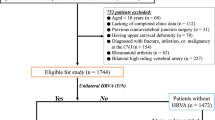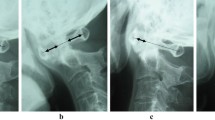Abstract
Purpose Atlantodens osteoarthritis and atlantoaxial osteoarthritis cause neck pain and suboccipital headaches. Currently, knowledge on the risk factors for atlantoaxial osteoarthritis is lacking. This study aimed to investigate the factors related to the increased risk of atlantoaxial osteoarthritis. Methods We analyzed computed tomography (CT) images of the upper cervical spine of 1266 adult trauma patients for whom upper cervical spine CT was performed at our hospital between 2014 and 2019. The degree of atlantoaxial osteoarthritis was quantified as none-to-mild (not having osteoarthritis) or moderate-to-severe (having osteoarthritis). Risk factors associated with atlantoaxial osteoarthritis were identified using univariate and multivariable logistic regression analyses. Results The study group included 69.4% men, and the overall average age of the study population was 54.9 ± 20.4 years. The following factors were independently and significantly associated with atlantoaxial osteoarthritis in the multivariable logistic regression analysis: age in the sixth decade or older (odds ratio [OR], 20.5; 95% confidence interval [CI], 6.2‒67.2, p < 0.001), having calcific synovitis (OR, 4.9; 95% CI, 2.4‒9.9, p < 0.001), women sex (OR, 3.3; 95% CI, 1.9‒5.7, p = 0.002), and not having atlantodens osteoarthritis (OR, 2.1; 95% CI, 1.2‒3.8, p = 0.014). Conclusion In the multivariable logistic regression analysis, age in the sixth decade or older, calcification of the transverse ligament, being women, and not having atlantodens osteoarthritis were found to be significantly associated with atlantoaxial osteoarthritis. Delayed diagnosis and treatment can be avoided by focusing on these risk factors.





Similar content being viewed by others
References
Hogg-Johnson S, van der Velde G, Carroll LJ, Holm LW, Cassidy JD, Guzman J, Côté P, Haldeman S, Ammendolia C, Carragee E, Hurwitz E, Nordin M, Peloso P (2008) The burden and determinants of neck pain in the general population: Results of the Bone and Joint Decade 2000–2010 Task Force on Neck Pain and Its Associated Disorders. Eur Spine J 17:39–51. https://doi.org/10.1097/BRS.0b013e31816454c8
Chiu TT, Leung AS (2006) Neck pain in Hong Kong: a telephone survey on prevalence, consequences, and risk groups. Spine. https://doi.org/10.1097/01.brs.0000225999.02326.ad
Badve SA, Bhojraj S, Nene A, Raut A, Ramakanthan R (2010) Occipito-atlanto-axial osteoarthritis: a cross sectional clinico-radiological prevalence study in high risk and general population. Spine 35(4):434–438. https://doi.org/10.1097/BRS.0b013e3181b13320
Halla JT, Hardin JG Jr (1987) Atlantoaxial (C1–C2) facet joint osteoarthritis: a distinctive clinical syndrome. Arthritis Rheum 30:577–582. https://doi.org/10.1002/art.1780300514
Schaeren S, Jeanneret B (2005) Atlantoaxial osteoarthritis: case series and review of the literature. Eur Spine J 14:501–506. https://doi.org/10.1007/s00586-004-0856-4
Zapletal J, Hekster RE, Straver JS, Wilmink JT, Hermans J (1996) Relationship between atlanto-odontoid osteoarthritis and idiopathic suboccipital neck pain. Neuroradiology 38:62–65. https://doi.org/10.1007/BF00593224
Adogwa O, Buchowski JM, Sielatycki JA, Shlykov MA, Theologis AA, Lin J, CreveCoeur T, Peters C, Riew KD (2020) Improvements in neck pain and disability following C1–C2 posterior cervical instrumentation and fusion for atlanto-axial osteoarthritis. World Neurosurg 139:e496–e500. https://doi.org/10.1016/j.wneu.2020.04.051
Fung M, Frydenberg E, Barnsley L, Chaganti J, Steel T (2018) Clinical and radiological outcomes of image guided posterior C1-C2 fixation for atlantoaxial osteoarthritis (AAOA). J Spine Surg 4(4):725–735
Grob D, Bremerich FH, Dvorak J, Mannion AF (2006) Transarticular screw fixation for osteoarthritis of the atlanto axial segment. Eur Spine J 15:283–291. https://doi.org/10.1007/s00586-005-0963-x
Elliott RE, Tanweer O, Smith ML, Frempong-Boadu A (2013) Outcomes of fusion for lateral atlantoaxial osteoarthritis: meta-analysis and review of literature. World Neurosurg 80:e337–e346. https://doi.org/10.1016/j.wneu.2012.08.018
Zapletal J, Hekster RE, Straver JS, Wilmink JT (1995) Atlanto-odontoid osteoarthritis. appearance and prevalence at computed tomography. Spine 20(1):49–53
Liu K, Lü Y, Cheng D, Guo L, Liu C, Song H, Chhabra A (2014) The prevalence of osteoarthritis of the atlanto-odontoid joint in adults using multidetector computed tomography. Acta Radiol 55:95–100. https://doi.org/10.1177/0284185113492722
Betsch MW, Blizzard SR, Shinseki MS, Yoo JU (2015) Prevalence of degenerative changes of the atlanto-axial joints. Spine J 15:275–280. https://doi.org/10.1016/j.spinee.2014.09.011
Li M, Liu S, Kong Q, Sun H, Zhang X, Wang G (2016) Incidence and age and gender profiles of hyperplasia in individual cervical vertebrae. J Int Med Res 44:917–922. https://doi.org/10.1177/0300060516645038
Zapletal J, de Valois JC (1997) Radiologic prevalence of advanced lateral C1–C2 osteoarthritis. Spine 22(21):2511–2513. https://doi.org/10.1097/00007632-199711010-00009
Lakshmanan P, Jones A, Howes J, Lyons K (2005) CT evaluation of the pattern of odontoid fractures in the elderly—relationship to upper cervical spine osteoarthritis. Eur Spine J 14:78–83. https://doi.org/10.1007/s00586-004-0743-z
Harata S, Tohno S, Kawagishi T (1981) Osteoarthritis of the alanto-axial joint. Int Orthop 5:277–282. https://doi.org/10.1007/BF00271083
Saylısoy S (2020) A case of acute calcium pyrophosphate arthritis in two rare sites of involvement: the cervical facet and atlantoaxial joint. Jt Dis Relat Surg 31:395–398. https://doi.org/10.5606/ehc.2020.74329
Feydy A, Lioté F, Carlier R, Chevrot A, Drapé JL (2006) Cervical spine and crystal-associated diseases: imaging findings. Eur Radiol 16:459–468. https://doi.org/10.1007/s00330-005-2776-z
Kobayashi T, Miyakoshi N, Konno N, Abe E, Ishikawa Y, Shimada Y (2014) Acute neck pain caused by arthritis of the lateral atlantoaxial joint. Spine J 14:1909–1913. https://doi.org/10.1016/j.spinee.2013.10.054
Hsu H, Siwiec RM (2021) Knee osteoarthritis. StatPearls Publishing, Treasure Island, FL
Jones G, Glisson M, Hynes K, Cicuttini F (2000) Sex and site differences in cartilage development: a possible explanation for variations in knee osteoarthritis in later life. Arthritis Rheum 43:2543–2549. https://doi.org/10.1002/1529-0131(200011)43:11%3c2543::AID-ANR23%3e3.0.CO;2-K
Ten Have HA (1978). Antero-posterior mobility and degenerative changes of the cervical spine. Thesis. Visdruk Alphen aan den Rijn, Leiden (in Dutch)
Koller H, Acosta F, Forstner R, Zenner J, Resch H, Tauber M, Lederer S, Auffarth A, Hitzl W (2009) C2-fractures: part II. A morphometrical analysis of computerized atlantoaxial motion, anatomical alignment and related clinical outcomes. Eur Spine J 18:1135–1153. https://doi.org/10.1007/s00586-009-0901-4
Acknowledgements
We would like to thank Editage (www.editage.com) for English language editing.
Funding
None.
Author information
Authors and Affiliations
Corresponding author
Ethics declarations
Conflict of Interest
The authors declare that they have no conflict of interest.
Additional information
Publisher's Note
Springer Nature remains neutral with regard to jurisdictional claims in published maps and institutional affiliations.
Rights and permissions
Springer Nature or its licensor holds exclusive rights to this article under a publishing agreement with the author(s) or other rightsholder(s); author self-archiving of the accepted manuscript version of this article is solely governed by the terms of such publishing agreement and applicable law.
About this article
Cite this article
Suga, Y., Shigematsu, H., Tanaka, M. et al. Factors associated with the increased risk of atlantoaxial osteoarthritis: a retrospective study. Eur Spine J 31, 3418–3425 (2022). https://doi.org/10.1007/s00586-022-07414-5
Received:
Revised:
Accepted:
Published:
Issue Date:
DOI: https://doi.org/10.1007/s00586-022-07414-5




